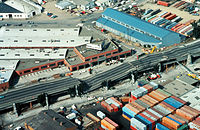
Photo from wikipedia
Abstract This study evaluates the effect of mainshock–aftershock sequences on the collapse of steel plate shear wall (SPSW) systems. For this purpose, three 9-, 14- and 20-story SPSWs are selected… Click to show full abstract
Abstract This study evaluates the effect of mainshock–aftershock sequences on the collapse of steel plate shear wall (SPSW) systems. For this purpose, three 9-, 14- and 20-story SPSWs are selected considering the practical range of heights used in this system. After numerical modeling of the structures, they are initially subjected to static-pushover analyses to evaluate their plastic behavior in large inelasticity regions. The incremental dynamic analysis is subsequently performed to capture the collapse capacity of the structures under aftershock excitations preceded by mainshocks that pose various levels of damage expressed in terms of maximum inter-story drift (MID). Evaluation of the median collapse capacities under aftershock excitations exhibit the same reduction ratios at similar mainshock MIDs for the different structures. This reduction is predicted via a quadratic polynomial for given mainshock MID values. Investigation of the mainshock-aftershock effects on distribution of the MIDs and maximum ductility demands at the collapse state shows that the prior mainshock damage mainly affects the collapse capacity by consuming the energy-absorption capacity of the infill plates, thus causing strength deterioration. Irrespective of the mainshock damage level, the structures were found to collapse when their first-story columns reach a threshold softening level.
Journal Title: Journal of Constructional Steel Research
Year Published: 2021
Link to full text (if available)
Share on Social Media: Sign Up to like & get
recommendations!